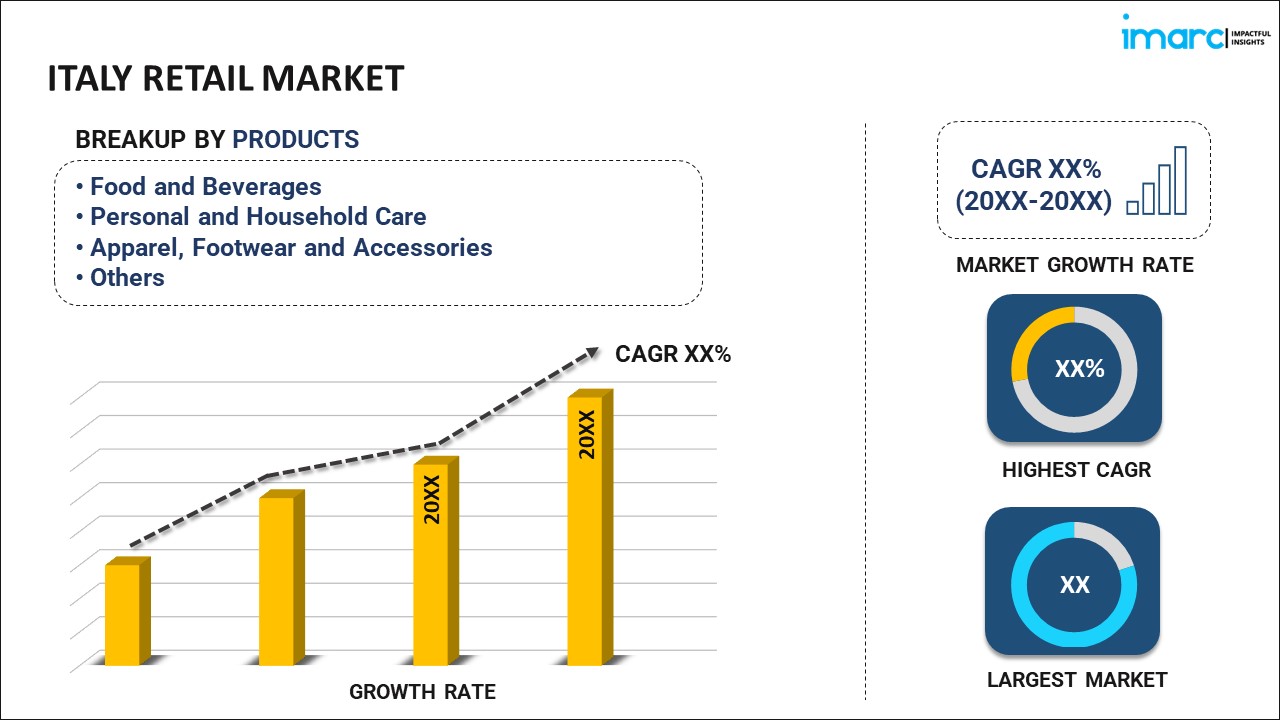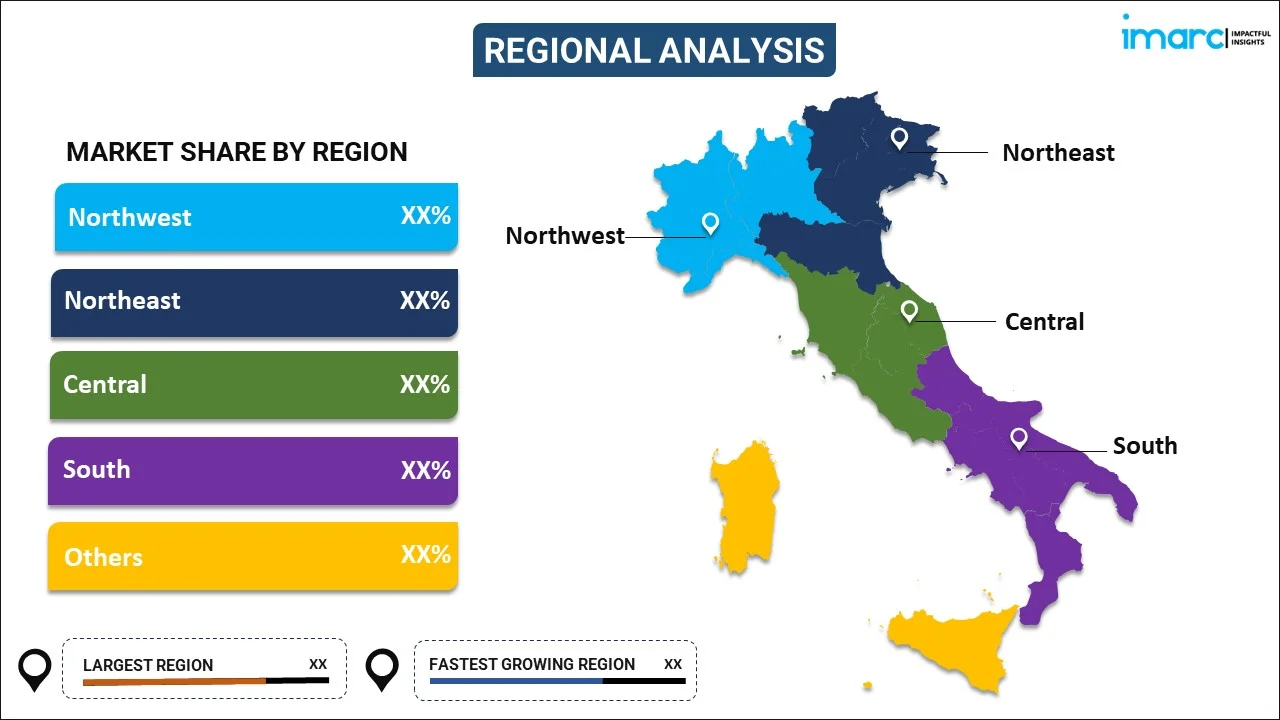
Italy Retail Market Report by Product (Food and Beverages, Personal and Household Care, Apparel, Footwear and Accessories, Furniture, Toys and Hobby, Electronic and Household Appliances, and Others), Distribution Channel (Supermarkets and Hypermarkets, Convenience Stores, Specialty Stores, Online Stores, and Others), and Region 2025-2033
Italy Retail Market Overview:
The Italy retail market size reached USD 698.6 Billion in 2024. Looking forward, IMARC Group expects the market to reach USD 860.2 Billion by 2033, exhibiting a growth rate (CAGR) of 2.34% during 2025-2033. The retail market in Italy is experiencing significant growth, fueled by rising online sales, increasing sustainability initiatives, and the blending of digital and in-store shopping experiences. Major sectors, such as food and grocery, are notably impacted, with hypermarkets and supermarkets playing substantial roles.
|
Report Attribute
|
Key Statistics
|
|---|---|
|
Base Year
|
2024 |
|
Forecast Years
|
2025-2033
|
|
Historical Years
|
2019-2024
|
| Market Size in 2024 | USD 698.6 Billion |
| Market Forecast in 2033 | USD 860.2 Billion |
| Market Growth Rate (2025-2033) | 2.34% |
Italy Retail Market Trends:
Rise in E-Commerce and Online Growth
In Italy the ecommerce sector is experiencing a significant growth mainly driven by technological advancements and the gradual shift in consumer preferences toward convenience and speed. As digital platforms nowadays become more sophisticated consumers are increasingly expecting seamless service that integrate online and offline experiences. According to a report published by International Trade Administration, Italian consumers are rapidly adopting digital services. Around 50 million (85% of the population) are using Internet and nearly 40 million people are shopping online in Italy. The 2022 ecommerce revenue in Italy reached an estimated €76 billion with about a 44% transaction it's still conducted in cash mobile and card transactions together account for approximately 40% of all sales. Retailers are also responding by enhancing their omnichannel strategies which involves synchronizing digital and physical touchpoints. This approach enables consumers to browse products online, check their availability in real time and choose between home delivery or in-store pickup. Such integrations not only improve consumer satisfaction by offering flexibility and efficiency but also helps businesses in maintaining their competitiveness in rapidly evolving retail landscape. The trend underscores a broader move towards a more interconnected end user centric shopping experience.
Sustainability and Ethical Consumerism
In Italy, sustainability and ethical consumerism are increasingly vital as consumer awareness of environmental impact grows. Retailers nowadays are stepping up their stainability efforts responding to a rising demand for more environmentally friendly products. For instance, according to a data published by the World Bank in November 2023, the World Bank has raised EUR 60 million from retail investors in Italy with a five-year fixed rate callable Sustainable Development Bond. The bond, due November 17, 2028, aims to support sustainable development activities. It offers a gross fixed rate quarterly coupon of 3.2% per annum and was listed on Borsa Italiana’s EuroMOT. The World Bank’s move is aimed at mobilizing private capital for sustainable development and addressing pressing global challenges like climate change. These initiatives not only cater to the eco conscious shopper but also help reduce waste and promote sustainable practices across the retail sector. By integrating these services retailers not only align with consumer values but also positioned themselves as a responsible leader in a market that values sustainability. This shift is transforming the retail landscape making sustainability a core component of business strategy.
Italy Retail Market News:
- In June 2024, UNIQLO announced that it is expanding in Italy with distinctive new stores in Rome and Milan. The UNIQLO Roma Via del Corso store opened in Rome, followed by the opening of a new store in Piazza Gae Aulenti in Milan. The Rome store embraces the city's classic and elegant atmosphere, offering exclusive services such as RE.UNIQLO Studio and UTme! Italy's first UTme! allows customers to create their own designs for unique printed T-shirts. Meanwhile, the new store in Milan features an ultra-modern design and offers men's, women's, and kid's lines along with contemporary furnishings provided by Kartell. Mark Barnatovic, UNIQLO Italy COO, expressed the brand's commitment to growing and consolidating its presence in Italy.
- In June 2024, Italian apparel brand Il Lanificio announced that it is set to expand its presence in Europe with new store openings in Pescara, Italy, on 7th June 2024, and the Aubonne, Switzerland, which is set to open in July 2024. The company’s CEO, Filippo Vadda, highlighted that the expansion aligns with its growth strategy, aiming to open six new stores in 2024. Since its acquisition in 2018, Il Lanificio has experienced a resurgence, with a 60% increase in store count and a 40% rise in revenues, signaling an ambitious growth trajectory.
Italy Retail Market Segmentation:
IMARC Group provides an analysis of the key trends in each segment of the market, along with forecasts at the country level for 2025-2033. Our report has categorized the market based on product and distribution channel.
Product Insights:

- Food and Beverages
- Personal and Household Care
- Apparel, Footwear and Accessories
- Furniture, Toys and Hobby
- Electronic and Household Appliances
- Others
The report has provided a detailed breakup and analysis of the market based on the product. This includes food and beverages, personal and household care, apparel, footwear and accessories, furniture, toys and hobby, electronic and household appliances, and others.
Distribution Channel Insights:
- Supermarkets and Hypermarkets
- Convenience Stores
- Specialty Stores
- Online Stores
- Others
A detailed breakup and analysis of the market based on the distribution channel have also been provided in the report. This includes supermarkets and hypermarkets, convenience stores, specialty stores, online stores, and others.
Regional Insights:

- Northwest
- Northeast
- Central
- South
- Others
The report has also provided a comprehensive analysis of all the major regional markets, which include Northwest, Northeast, Central, South and Others.
Competitive Landscape:
The market research report has also provided a comprehensive analysis of the competitive landscape. Competitive analysis such as market structure, key player positioning, top winning strategies, competitive dashboard, and company evaluation quadrant has been covered in the report. Also, detailed profiles of all major companies have been provided.
Italy Retail Market Report Coverage:
| Report Features | Details |
|---|---|
| Base Year of the Analysis | 2024 |
| Historical Period | 2019-2024 |
| Forecast Period | 2025-2033 |
| Units | Billion USD |
| Scope of the Report | Exploration of Historical Trends and Market Outlook, Industry Catalysts and Challenges, Segment-Wise Historical and Future Market Assessment:
|
| Products Covered | Food and Beverages, Personal and Household Care, Apparel, Footwear and Accessories, Furniture, Toys and Hobby, Electronic and Household Appliances, Others |
| Distribution Channels Covered | Supermarkets and Hypermarkets, Convenience Stores, Specialty Stores, Online Stores, Others |
| Regions Covered | Northwest, Northeast, Central, South, Others |
| Customization Scope | 10% Free Customization |
| Post-Sale Analyst Support | 10-12 Weeks |
| Delivery Format | PDF and Excel through Email (We can also provide the editable version of the report in PPT/Word format on special request) |
Key Questions Answered in This Report:
- How has the Italy retail market performed so far and how will it perform in the coming years?
- What is the breakup of the Italy retail market on the basis of product?
- What is the breakup of the Italy retail market on the basis of distribution channel?
- What are the various stages in the value chain of the Italy retail market?
- What are the key driving factors and challenges in the Italy retail?
- What is the structure of the Italy retail market and who are the key players?
- What is the degree of competition in the Italy retail market?
Key Benefits for Stakeholders:
- IMARC’s industry report offers a comprehensive quantitative analysis of various market segments, historical and current market trends, market forecasts, and dynamics of the Italy retail market from 2019-2033.
- The research report provides the latest information on the market drivers, challenges, and opportunities in the Italy retail market.
- Porter's five forces analysis assist stakeholders in assessing the impact of new entrants, competitive rivalry, supplier power, buyer power, and the threat of substitution. It helps stakeholders to analyze the level of competition within the Italy retail industry and its attractiveness.
- Competitive landscape allows stakeholders to understand their competitive environment and provides an insight into the current positions of key players in the market.
Need more help?
- Speak to our experienced analysts for insights on the current market scenarios.
- Include additional segments and countries to customize the report as per your requirement.
- Gain an unparalleled competitive advantage in your domain by understanding how to utilize the report and positively impacting your operations and revenue.
- For further assistance, please connect with our analysts.
 Request Customization
Request Customization
 Speak to an Analyst
Speak to an Analyst
 Request Brochure
Request Brochure
 Inquire Before Buying
Inquire Before Buying




.webp)




.webp)












